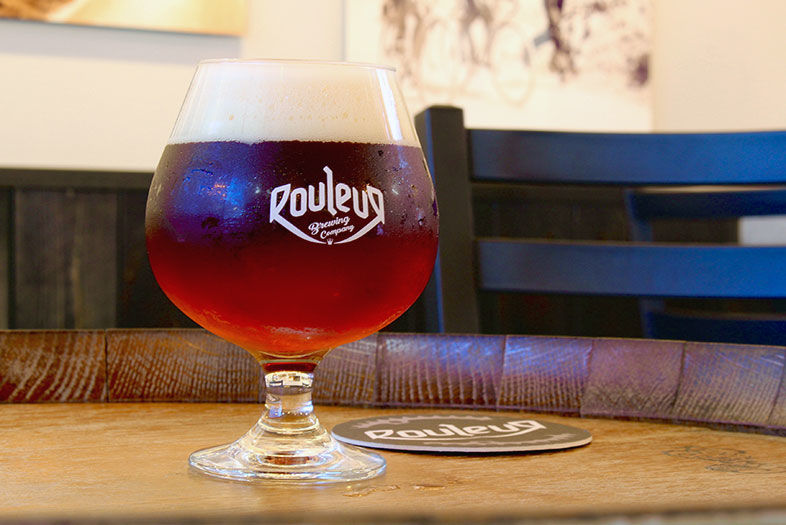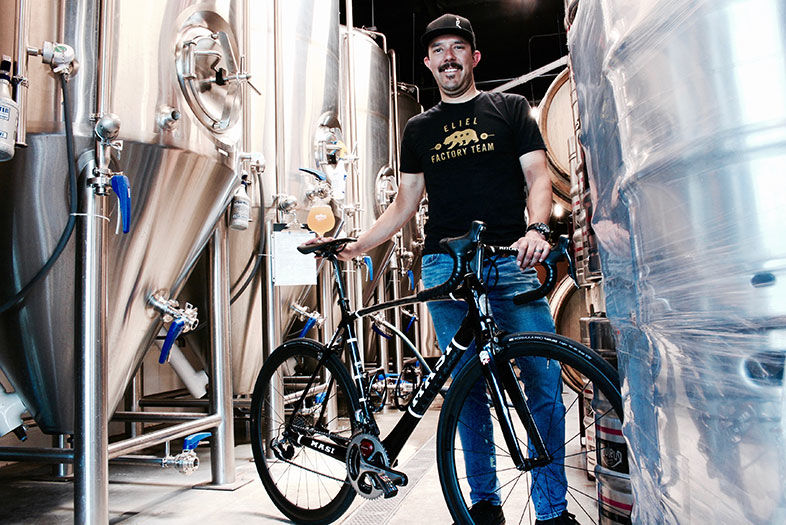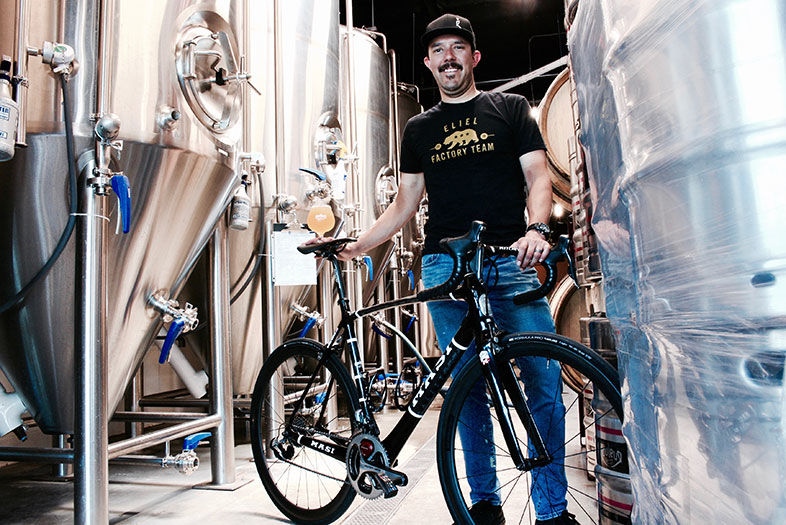One common trope about business says that if you can combine your passion with your livelihood, you’ll be a success. If that’s true, then Rawley Macias has twice the mojo working for him. His Carlsbad brewery, Rouleur Brewing Company, combines his love for beer and his love of cycling into one going concern. The result is a brewery and a tasting room that feels cozy, comfortable, and curated with distinctly personal touches. Unlike some breweries that vie for attention by cultivating a “marketing hook,” the cycling theme at Rouleur is not a gimmick. Instead, it reflects the owner’s sincere passion, and the experience is—believe it or not—refreshingly charming.
Rawley Macias is also a good brewer. For the past year, he has turned out an admirable variety of solid, well-crafted brews, with a particular talent for Belgian styles, hoppy beers, and a new-found love of lagers. With a glass of Boneshakeur Pilsner in hand (deliciously crisp and hoppy), I sat down with Rawley to reflect upon the passing of his one-year anniversary, the unique challenges and advantages of being a Brewery Igniter startup, and why he thinks Rouleur (pronounced “ruler” or “ru-lair”) has been able to survive the past year when others have not.
Congrats on celebrating your one-year anniversary at the end of March.
Thanks. The event was end of March, but technically, the actual date of our grand opening was April 8.
That’s no small achievement. Especially these days.
Thank you. It’s been a fun ride.
What would you say was the biggest surprise of the past twelve months?
It was definitely an eye-opener when my Brewery Igniter neighbor went out of business. He [Wiseguy] was the first Brewery Igniter brewery to go out of business and he was also the youngest. Wiseguy and Rouleur are still the youngest breweries in the program. It was kind of eye-opening because we were just getting going, in my opinion, and he was closing his doors.
Did you have any inkling that they were in trouble?
We talked.
Was it that your tasting room was full all the time and theirs was empty?
No, we both had growing pains together. The biggest issue—and I’ve talked about this in other interviews—is our location. It’s just that we’re hidden way back in a business park. We’ve had to be creative so we could survive. We’re a new brand, I don’t have a pedigree brewer, and I didn’t leave one brewery where I already had a following to found my own. Same with our neighbors last year—they were new as well. But you have to have the capital to survive while your brand is growing. Every month we get stronger and every month we get more sales, so we’re growing. But it’s critical to have that money to survive and to weather that first year, at least.
So what do you think is helping you the most right now in terms of getting your name out there and growing? Is it social media?
Social media helps, but I’d say that 90% of our customers are regulars and they just spread the word. We get a following of people and it seems like it keeps growing. They become really loyal. I’m really proud of our beertenders here. They remember people’s names and what’s going on in people’s lives. So a lot of people come back just to see Sam or Liz or our new guy, Ryan, who is already making a good impression. I think that really helps a lot. People come and they really feel welcomed and they feel like they belong. Plus we’re into cycling, as you can see, so we have a lot of group activities we’re involved in. We’re involved in the cycling industry a lot; teams will hold their Christmas party here or companies will do product launches here. So, when that starts happening, you start getting opportunities left and right to be more involved in the cycling community. And thirdly, I think some of our success is due to the fact that we haven’t released a bad beer and we’ve gotten some accolades on our beer and that’s starting to finally pop its head out. People are starting to hear about us and we’re starting to get some key accounts, like Yard House.
So you’ve been able to grow the draft accounts. What are people asking for the most?
You know, when we first launched—and this was partly my fault, I didn’t mean for it to come across this way, but it did—we had a heavy Ameri-Belgian lineup. And really the goal of Rouleur was to not adhere to any one style, but when we launched we had a lot of Belgian-inspired beers. Immediately after we opened a lot of people started calling us a “Belgian brewery,” and in a way that was true, because the first seven beers all had a Belgian yeast. But after that we started doing other beers, which was in our plan, but it never really percolated down to the audience. They thought Belgian, Belgian, Belgian.
Actually, a “rouleur” in cycling is a person who does well in all venues, right? A kind of “all-rounder”?
Yeah, it’s a cycling term for an all-arounder. In the sport of cycling, there are guys who are sprinters and guys who are set up to be supporters, and there’s also climbers, but the French term in cycling, the rouleur is the guy the team can depend on to do a bunch of stuff and he’s not a one-trick pony. So that was kind of our brewing style, but it was probably confusing that when we launched we had so many Belgian beers and people immediately saw us as another Belgian brewery. So we had to break that misconception the best we could. We don’t have a huge marketing budget, so what we did was we started launching other beers that weren’t Belgian. Now, our accounts are realizing that we have American IPAs, we have a hazy IPA, and we even have this New Zealand Pilsner, which we’re drinking right now. There’s nothing Belgian about that! In fact, I think at this point only about 30% of the beers in our lineup are Belgian inspired.
What are your fans and followers asking for when they come in here?
Dopeur Juicy IPA. By far. Also, this Boneshakeur New Zealand Pilsner, which I’m pretty proud of. It’s turning out to be a really good seller. It’s partly because it’s new and partly because people have gotten really into crisp, dry lagers with a little bit of hop bitterness. But we have the whole range here. You can get a Belgian Golden Strong. We have three pale ales. But out of all of them, the Dopeur is the number one seller.
It seems nobody can ever get away from the popularity of the IPA, right? Does that frustrate you ever, as a brewer? Do you ever kind of wish people were into the more offbeat stuff?
Yeah, sure. But the biggest change—or the thing you learn the quickest when you open your own brewery—is that your passion for a particular style may not always be the beer that sells. So you have to balance brewing beers that you’re truly passionate about with the fact that you’re no longer brewing as a hobby, you’re brewing in order to make money. It’s a business. So you have to make those beers that get people in the door. Once they’re in the door and they start trusting your beers, then they start experimenting and ordering a different style, like a radler, which is part juice, part beer. It’s fun teaching people about beer; a lot of people come in, and they love beer, but they don’t really know that much about it. They may say, “I don’t really like bitter beers, but I love IPAs.” So sometimes you have to kindly teach folks what they’re actually tasting.
Are there beer styles you haven’t done yet that you’re itching to do?
We definitely want to do sours. We are limited by a small space, so a barrel program is a challenge. We have a sour blonde that has almost been aging for nine months—it was supposed to be released on our one-year anniversary, but it just wasn’t ready. I’m really excited about it because it will be a true sour, not a kettle sour (no knock on kettle sours) but true sours just take time. They have a mind of their own. We also want to do more with lagers. We do some contract brewing and we’ve done some lagers for contracts and we believe we do them well. So we want to do more of those, especially coming up on summertime—maybe even can some lagers.
I’m not sure if this is a true statement, but I think we’re one of the only breweries in San Diego that does a true radler beer. A radler is kind of like a shandy, it’s basically a blend of real juice (usually lemonade or grapefruit) and beer blended and carbonated in the bright tank. There are breweries that take one of their finished beers on draft and then they add juice to it in the glass. That, in my opinion, is not a true radler. That’s a beer-mosa or something. But a radler—the reason it fits our brand so well is that it was developed in the 1820’s in Germany and—I haven’t verified the story—supposedly there was huge bike ride with several thousand cyclists and they ended the race at this pub, but the pub knew they weren’t going to have enough beer to serve all the cyclists so they cut the beer with juice. The cyclists loved it and started to request it. Now, in Germany and Austria, there are a bunch of radler producers—Stiegl is one of the most famous. It’s a refreshing beer because it has true juice and beer in it, and ours is doing really well. People really love it.
What would you say was the biggest win of your first year in business?
Being in the black, albeit by very little, starting in month nine. That’s without paying myself. I haven’t drawn a cent; I’ve only paid myself in beer. And being associated with the bike industry I get a lot of loaners and parts and stuff like that. So that’s kind of a cool thing, but I haven’t paid myself any money. We are, however, making enough to cover the costs of our Brewery Igniter lease, which is pretty expensive, and we can pay our employees and our staff, and recoup our costs, so that’s a pretty good thing. So I think that was our biggest win, to be able to do that within nine months with a very small team. That’s maybe one reason we were able to do it; we had very few people and they were all wearing multiple hats. And, truthfully, I’m a first-time business owner and a first-time brewery owner and there was so much to learn besides just the beer.
What were you doing before this?
I was in engineering. I was working a normal 40-hour-a-week job, making well into the six figures as a level five engineer. So it was weird to go from that to not paying myself. But I was prepared for it. (My wife is still working; she’s a nurse.)

Have a Beer with Rouleur’s Rawley Macias
Sprinteur is an American-Belgian inspired red ale that combines big malt and dark fruit notes with a classic West Coast hop influence. | Photo: Bruce Glassman
So what was the “Aha!” moment where you were sitting at your desk with your six-figure job and you decided you were done with it and it was time to open a brewery?
Well, my original plan was to open a brewery eventually, and I was going to do it the way most people do it; you have to raise the money, you have to find a building, you have to build it out, and so on. I heard about Brewery Igniter years ago, I put my name on an interest list on the web site—I completely forgot that I had done this, by the way—and one day I was at work and they called me and said, “Hey, you’re next on the list for a site that we’ll be opening in a year in Carlsbad.” So I took my business plan that I had been working on for a long time—I had to change it drastically to match the Brewery Igniter model—and then it was kind of a poop-or-get-off-the-pot scenario. I have two kids at home, a wife who works, we were stable enough financially, we’re young enough, and I figure I’ll always have my engineering degree, it’s not like it’s going somewhere. So we decided to try it out.
There are some unique challenges to being a Brewery Igniter brewery, wouldn’t you say?
I would say the biggest pitfall is that you kind of get to choose your location, but you kind of don’t. You can either sign or you don’t sign. So having to take whatever the location is can be one limiting factor. Another downside is that some of the layout is not optimal. Your cold box space, for example, doesn’t match the ratio of how much cellar capacity you have, which doesn’t match the storage room. We have a big brewhouse, a 10-barrel and five 20-barrel fermenters, but if I started moving that at maximum capacity I would have nowhere to put the beer. I’m maxed out in my cold box, but I’m only operating at half capacity. And then you look at the height inside the cold box and you can see that there’s space inside to go up much higher, but they only made the door halfway up the height and you can’t get a forklift in there, so there’s all this wasted volume.
How long before you outgrow this space—or have you already?
From a storage perspective we have, but in terms of brewing capacity, not at all. I estimate that these systems can do just over 2,000 barrels a year and we’re not there yet. Last year, in our first year, we did just over 400 barrels. Then, on top of that, we also do contract brewing where we rent out some of our capacity to other brewers.
Alright, so you’re going to ramp up production somewhat in the next year, what else do you have in mind to accomplish before your second anniversary?
Well, I have a concept, but it requires money.
Don’t they all!
I think some breweries are too dependent on the income from their tasting room and when the tasting room starts to slow down, they get in trouble. But I do think that Rouleur specifically doesn’t get the benefit that most breweries get from a tasting room, because of the lack of foot traffic and the area, tucked back in this business park. So we are looking at the potential of having a second tasting room pretty soon and it might have a bike shop component to it. Not a bike shop where you’re selling bike parts and bicycles, but more high-end custom built bikes. It’s a model that you see in Colorado a lot, where there’s coffee and a tasting room and then there’s some kind of physical activity component and it becomes a real gathering spot. We are way into cycling so that helps us and really matches our brand. So I’m looking at that, but any tasting room is going to be $150 to $200 a square foot to build out, so a 1,000-square-foot tasting room is going to be about $200,000. There are ideas I have to raise it, but the money’s not sitting in our bank account right now.
There’s a lot of talk lately about all the competition in San Diego and how brewery growth may be slowing down, but you obviously still feel it’s a good place to be. What do you think is the best thing about being a San Diego brewery right now?
Truthfully, I feel if my brewery can survive in San Diego, one of the beer capitals of the country, then I’m confident that wherever my future might be—say ten years from now I’m not in San Diego—I feel I should be able to do well in places that are actually low on breweries. People have so many options here—there are five or six breweries all within a few miles of ours—so I feel if people are choosing to come into my brewery, we must be doing something right.
Follow Bruce on Instagram: @sdbrewdude

Have a Beer with Rouleur’s Rawley Macias
PARTNER CONTENT
Rouleur founder Rawley Macias created a brewery that combines his love of cycling with his love of beer. | Photo: Bruce Glassman


















